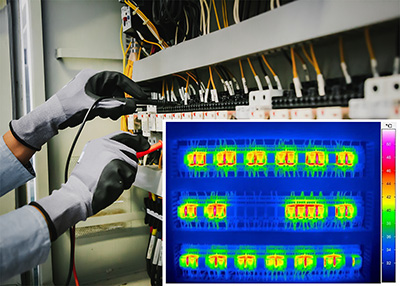Revealing the invisible: how thermographic imaging is transforming electrical inspections
23/05/2025
When it comes to electrical systems, what you can’t see can hurt you. Behind walls, within panels and along cable runs, excessive heat build-up, often invisible to the naked eye, can be a silent indicator of potential failure or even fire risk.
Thermographic imaging cameras offer a powerful tool that allows inspectors to ‘see’ heat and uncover hidden issues before they escalate. By visualising temperature differences across components, thermographic inspections provide a non-invasive, real-time method to detect overloaded circuits, loose connections and deteriorating equipment, making them an indispensable asset for preventative maintenance and safety assurance in both residential and industrial environments.
The use of infrared (IR) thermography in electronics and the electrical industry allows contactless measurement of surface temperatures to be performed with an infrared camera without contacting temperature sensors. It is an elegant, non-invasive optical temperature measurement method for simultaneous and temporally high-resolution detection of a number of measurement points.
Thermal imaging provides a fast overview of the conditions of electrical installations, as hotspots are a good indicator of faults when conducting comparative thermography. Reliable detection of hotspots requires a sufficiently high number of pixels and load conditions also have to be kept in mind during thermographic measurements. The important flexibility of infrared camera systems is reached through the use of interchangeable lenses.
Inspections of electrical installations mostly focus on the detection of hotspots, which are areas with excessive temperatures. These can often be identified by comparison with similar components that have different temperatures. For example, one phase can have a higher temperature in comparison with other phases due to poor insulation that results in a creeping current. Already, such a comparative analysis, called qualitative thermography, is absolutely sufficient in many inspection situations.
 | ||
| Thermal imaging provides a fast overview of the condition of electrical installations, as hotspots are a good indicator of faults |
To provide a secure conclusion, the infrared camera being used needs to come with an adequate resolution. When inspecting electrical installations, the geometrical resolution in particular should be focused on, which is the number of pixels available for the measurement. The more available pixels, the smaller the hotspots that can be detected from a certain distance and the earlier a developing fault can be discovered, resulting in a more secure inspection result. An infrared camera with a correspondingly large detector format does not therefore determine average values from hotspot temperatures and lower ambient temperatures. Rather, this would prevent the reliable detection of a hotspot.
Load behaviour is very important for thermographic analyses of electrical installations. When thermographic measurements are conducted in low-load situations, hotspots will not be detectable securely as those areas will appear a lot colder than when running at full load. Therefore, either the measurements will be carried out at full load or the measured lower temperatures will be converted to those that would be measured when running at full load.
Very often, thermography is used for controlling high-voltage installations outdoors. To carry out these measurements correctly, measuring the smallest details, full-signal telephoto lenses should be used. In contrast, limited space indoors could well result in the need to use wide-angle lenses for coverage of complete switchboards.
Depending on the respective task, users can ensure the equipment selected is configured to meet their specific needs. The starting point will usually be the thermographic camera. Cooled or uncooled detector? Which detector format? Shall the thermographic system support lock-in thermography? How much flexibility is desired for the distance between the measurement object and the camera? What influence does this have on the choice of microscopic lenses and close-ups?
All interchangeable standard lens systems of InfraTec’s ImageIR series, available from Quantum Design UK and Ireland, can be combined with a motor focus unit, which is controlled by the camera operating software. It enables precise, remote and fast focusing. In addition, an autofocus function is available, which operates reliably even with low-image contrasts.
The very robust light metal housing is available with IP67 protection and protects the camera against mechanical and thermal stress. In conjunction with the protection degree preserving LEMO connectors, it is suited for use in harsh industrial environments. For applications under extreme environmental conditions, suitable protective housings are also available, for example those made from stainless steel, which can optionally be equipped with a cooling and heating system.
InfraTec’s infrared cameras with cooled and uncooled detectors have native resolutions up to (2560 × 2048) IR pixels. Spatially high-resolution thermograms ensure that components and assemblies are imaged down to the smallest detail and thus defects can be reliably detected and precisely localised.